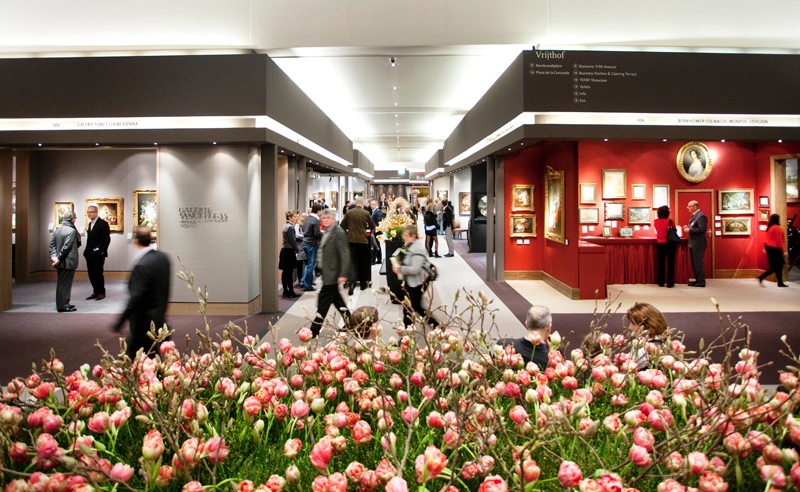
Maastricht in the Tulips – Let a Thousand Flowers Bloom, Let a Thousand Buyers Buy
Bookies in London, where you can bet legally on anything, are giving three to one odds that Edvard Munch’s The Scream selling at Sotheby’s in May will bring $120 million, $40 million more than its high estimate of a mere $80 million. Is the auction house playing “Find the Russian”? “No,” an auction insider told me, “Find three Chinese.”
The European Fine Art Fair in Maastricht found more than 100 Chinese collectors and dealers to accept its invitation to the event that began on March 15 and runs through the 25th of the month. More Chinese were already planning to come. And those Chinese buyers bought.
The news at the fair was that China had overtaken the United States as the most important art-buying region in the world, in an art market that had risen from 2010 to 2011 by 5% to 46 million euros. That market also rose 63% from its deepest drop in 2009. (The euro is about $1.31.)

Why Is This Animal Smiling? Elegant Jade at Maastricht - 2012 Is the Year of the $2 million Buffalo
Here are some other statistics in a market where transactions beyond the auctions are elusive, and hard to document —
∎ China overtook the US for the first time in 2011 to become the largest art and antiques market worldwide with a share of 30% based on both auction and dealer sales.
∎ The US share dropped by 5 percentage points to 29% while the combined total for the 27 European Union countries was also down by 3 percentage points to 34%. Among the EU nations, the largest markets were the UK with 22% of the global total and France with 6%, both unchanged.
∎ The Chinese art and antiques auction sector was the strongest growing market worldwide with a dramatic rise of 177% in 2010 and a further 64% in 2011.
∎ The global art market continued to recover in 2011, increasing by 7% to €46.1 billion, an increase of 63% since the market crisis of 2009. The volume of transactions also increased by 5% to 36.8 million.
∎ The driving forces behind the recovery were strong sales in the Chinese auction market and the rise of fine art sales (over decorative art).
∎ The Modern and Contemporary sectors combined to account for nearly 70% of the fine art market. Both continued a strong recovery in 2011, leading them to levels in excess of the boom of 2007-2008.
∎ The art market took nearly a decade to recover from the recession of the 1990s whereas the contraction in 2009 has been relatively short-lived. This is due, in part, to its increasingly global nature.
∎ The art market has more than doubled in size in the 25 years since TEFAF Maastricht was founded and grew over 575% from its lowest point in 1991 (just under US$10 billion) to its highest in 2007 (US$66 billion/€48.1 billion).
Yes, the 1% have done well. Read more about the state of the market in a study conducted for TEFAF by Clare McAndrew of Arts Economics.
The staff at Ben Janssens Oriental Art (based in London) moved briskly, taking objects off view and putting new ones in their place. Janssens, the chairman of the fair, traveled to China last year to meet and invite potential visitors. His strategy worked.
At the booth of Vanderven Oriental Art, Clemens Vanderven, who has sold Chinese objects at Maastricht since the fair began 25 years ago, said that his sales on the first night of TEFAF 2012 exceeded the amount of his total sales at the fair last year.
“This place has the feel of a pilgrimage site,” he said. “All the major dealers are here, even though it’s Asia Week in New York. They go where they can get the best turnover.”
A few hundred yards away in the vast arena, at Priestly & Ferraro Chinese Art, Chinese visitors would stop and gaze at a jade water buffalo from the 18th century. The glowing grinning pale green animal weighed about 20 pounds, David Priestly said. The price was $2 million euros, and the relatively affordable object had an allure that eclipsed that of a stone slab by Henry Moore at Landau Fine Art of Montreal that, at $35 million, was said to be the most expensive work at TEFAF.
At Martyn Gregory, where views of Chinese harbors from the 19th century lined the walls, a picture of Shanghai from before it was Shanghai, was priced at $366,000.
Besides positioning itself to meet the growing demand from mainland and overseas Chinese, TEFAF has a rigorous vetting process, which minimizes the prospect of fakes being offered there. Fakes has proliferated in China. Western dealers say some are remarkably convincing.

A Twentieth Century Scholar's Rock Was at Gisele Croes Arts d'Extreme Orient (Brussels) at TEFAF
“Anything that you buy in Maastricht is going to be safe,” said Michael Goedhuis, ”As there are so many fakes emerging in China – very good fakes, very convincing fakes, especially in jade and porcelain – it’s reassuring for the Chinese to be able to feel that they are not buying fakes.”
TEFAF runs in Maastricht through March 25. More soon
